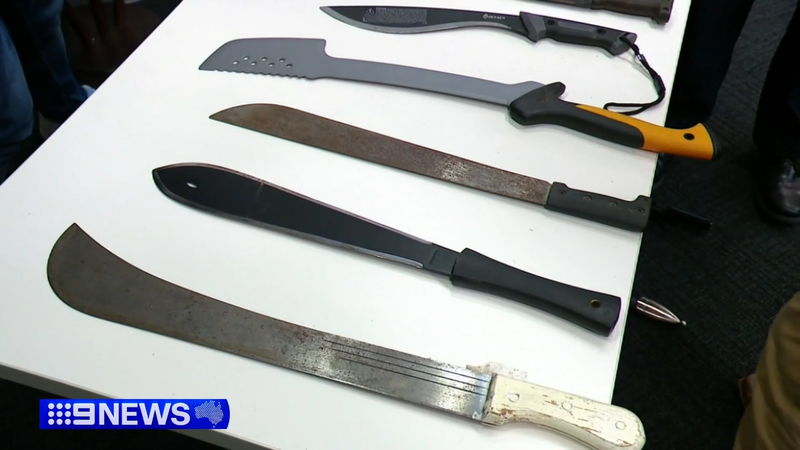
South Australians have been quietly handing over thousands of weapons in recent months, from machetes to swords, in an unprecedented show of compliance.
Behind these numbers is a sweeping crackdown that has already reshaped the state’s approach to knife crime.
Now, as the toughest laws in the nation take shape, the question is whether this bold experiment will change the game for good.
The response has been staggering—2,353 dangerous weapons surrendered at police stations in just three months, including 1,156 machetes and 722 swords.
Authorities said the voluntary amnesty revealed how many lethal items had been sitting unnoticed in homes across South Australia.
But the hand-in program was only the beginning of Parliament’s sweeping reforms, which have been rolled out in a three-phase plan.
The urgency was driven by data showing a 15 per cent rise in knife-related incidents up to October this year compared to the same period in 2023.
Last year, there were 4,706 offences involving knives and bladed weapons, more than 200 higher than 2022.
Yet the early signs were promising, with reductions already seen in aggravated robbery, sexual assault, assaults on police, and common assault.
'South Australia now has the toughest knife laws anywhere in the country.'
According to the Australian Bureau of Statistics, more than half of robberies involved a weapon, with knives used in over a third of cases.
These figures were not just statistics—they reflected victims, families, and communities affected by violence.
A three-phase reform plan
The reforms were rolled out in three stages.
Phase 1, now in place, gave police expanded powers to conduct wand searches at declared shopping centres, transport hubs, and licensed venues.
Phase 2, taking effect from 1 July 2025, banned knife sales to minors and introduced the harshest penalties in the nation for suppliers—up to four years in prison or fines as high as $35,000.
Phase 3, beginning 1 July 2026, would force retailers to lock or tether knives in display areas accessible to the public.
What the amnesty revealed
2,353 total weapons
1,156 machetes
722 swords
Additional dangerous knives
The amnesty runs until end of September 2024 at any police station outside the CBD.
What this means for shoppers
From Bunnings to camping shops, everyday shopping trips would soon look different, with knives locked behind cabinets or tethered for safety.
Customers would still be able to inspect items with the help of staff, while online retailers must warn buyers it is unlawful to sell knives to anyone under 18.
Other states had knife restrictions, but South Australia’s system was unmatched in its scope.
The crackdown targeted not just possession but the entire supply chain, while machetes and swords were now classified as prohibited weapons.
Exemptions existed for legitimate uses like martial arts or historical collections, provided proper documentation was secured.
What makes the laws the toughest
- Highest penalties for supplying knives to minors ($35,000 fine or 4 years jail)
- Mandatory secure storage in retail premises
- Prohibited weapon status for machetes and swords
- Expanded police search powers and online sales restrictions
How it compares globally
The strategy also stood out internationally.
While knife crime in Australia had been stable or declining for years, countries like the UK and Canada were grappling with rising incidents.
London, for instance, recorded an 18 per cent surge in knife crime between 2022 and 2023.
For seniors, the changes brought peace of mind as fewer weapons would be accessible in shops or homes.
Those managing estates or decluttering were reminded that exemptions applied but required checking legislation or seeking legal advice.
Everyday cutlery and disposable plastic or wooden knives remained unaffected by the rules.
Did you know?
Why dinner knives are rounded The tradition dates back to 1669 when King Louis XIV of France, concerned about violence, passed a law requiring all table and street knives to have their pointed tips ground smooth.
Operation Meld’s role
Since 1 January 2024, Operation Meld had seized 44 knives from known youth offenders and identified around 20 suspects.
This targeted policing, combined with sweeping legislative reform, was already paying dividends.
South Australia also had the lowest youth crime rate of any state in the country, reinforcing that proactive strategies worked.
The amnesty would run until the end of September, after which penalties would apply in full.
What This Means For You
Thousands of weapons, including machetes and swords, were handed in during the amnesty—an extraordinary reminder of how many dangerous items were sitting in homes across the state. The reforms also introduced the harshest penalties in the country for anyone supplying knives to minors, making it clear that the government was serious about prevention.
By July 2026, retailers would even be required to lock away or tether knives on display, ensuring tighter control at every level of access. Taken together, these steps positioned the state as a leader not only across Australia but also when measured against international efforts to combat knife crime.
For older Australians, this means safer shopping trips, fewer weapons in circulation, and a stronger sense of security in the community you call home.
If you’re interested in seeing how strict penalties are being enforced under similar knife laws, there’s a real-world example that highlights the impact of these measures.
This next story shows how authorities are issuing substantial fines on a weekly basis, demonstrating the seriousness of compliance and the legal consequences of carrying knives without a lawful reason.
It’s a practical follow-up that helps put the recent reforms into context and shows the tangible outcomes of stricter legislation.
Read more: Fines of up to $80,000 are being issued weekly under the new law
Youth crime drops as nation-leading knife laws pass Parliament — Outlines South Australia’s passage of the nation’s toughest knife laws and confirms the state has the lowest youth crime rate.
https://www.agd.sa.gov.au/news/youth-crime-drops-as-nation-leading-knife-laws-pass-parliament
More measures to crack down on knife crime — Provides data showing a 15 per cent rise in knife and bladed weapon incidents up to October 2024 compared to 2023.
https://www.agd.sa.gov.au/news/more-measures-to-crack-down-on-knife-crime
More measures to crack down on knife crime — Reports early reductions in aggravated robbery, sexual assault, assaults on police, and common assault following new measures.
https://www.premier.sa.gov.au/media-releases/news-archive/more-measures-to-crack-down-on-knife-crime
Recorded Crime—Victims, 2024 — Provides statistics showing that most robberies (55 per cent) involved weapons, with knives accounting for 35 per cent of incidents.
https://www.abs.gov.au/statistics/people/crime-and-justice/recorded-crime-victims/latest-release
Knife Crime Laws — Explains the ban on selling knives to minors and outlines penalties for suppliers, including up to four years in prison or $35,000 fines.
https://www.agd.sa.gov.au/law-and-justice/legislation/knife-crime-laws
Knife Crime Laws — Details requirements for retailers to lock or tether knives in public display areas and outlines exemptions for legitimate uses.
https://www.agd.sa.gov.au/law-and-justice/legislation/knife-crime-laws
After a spate of recent stabbings, is knife crime getting worse in Australia? — Analyses trends showing that knife crime in Australia has remained relatively stable while rising in the UK and Canada.
https://theconversation.com/after-a...knife-crime-getting-worse-in-australia-239925
More measures to crack down on knife crime — Summarises targeted policing operations, including Operation Meld, which seized 44 knives and identified around 20 persons of interest since January 2024.
https://www.agd.sa.gov.au/news/more-measures-to-crack-down-on-knife-crime
Would you welcome similar laws in your own community, or do you believe South Australia has gone too far?







